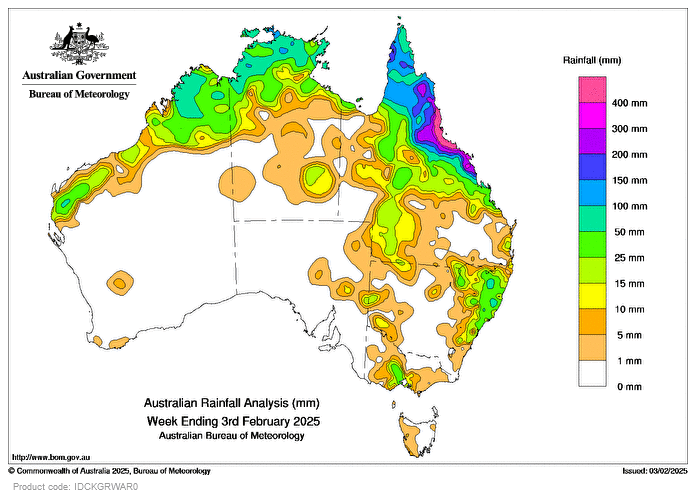A slow-moving low-pressure system brought several days of widespread and heavy rainfall to the North Tropical Queensland coast during the past week. Many sites recorded daily rainfall totals ranging from 200-700mm, with some locations experiencing seven-day rainfall totals exceeding 1000mm. This prolonged period of significant rainfall resulted in major flash and riverine flooding along Queensland’s tropical east coast, particularly between Tully and Ayr. Numerous sites across northern Queensland reported their highest daily or multi-day rainfall on record.
In addition to the heavy rainfall in Queensland, weekly rainfall totals of 50-100mm were recorded in the Top End of the Northern Territory, parts of north-western Western Australia, and isolated areas of north-eastern New South Wales. Further north, weekly rainfall totals of 100-200mm were observed across northern Queensland and in isolated pockets of the Northern Territory’s Top End. The most significant rainfall amounts were recorded in northern Queensland, with totals exceeding 200mm in many areas. The North Tropical Coast and Tablelands, as well as the Herbert and Lower Burdekin districts, experienced rainfall totals surpassing 300mm.
One notable observation was the highest weekly total at a Bureau gauge, which was 1697mm at Cardwell Range in Queensland. This total included the highest daily rainfall of 626mm within a 24-hour period ending at 9am on February 3rd.
The impact of this intense rainfall event was captured in the images above, showcasing the extent of the flooding and the forecasted rainfall patterns. The first image depicts the heavy rainfall experienced in North Tropical Queensland, while the second image provides a visual representation of the forecasted rainfall patterns over the affected regions.
It is crucial for residents and authorities in these regions to remain vigilant and prepared for potential further flooding and associated hazards. The excessive rainfall has already led to significant flooding, and continued monitoring of weather updates and warnings is essential to ensure the safety of individuals and communities in the affected areas.
As climate patterns continue to evolve, events like these serve as a reminder of the importance of proactive planning and response strategies to mitigate the impact of extreme weather events. The resilience of communities in the face of such challenges is commendable, and ongoing support and resources will be crucial in the recovery and rebuilding efforts following this devastating rainfall event.




